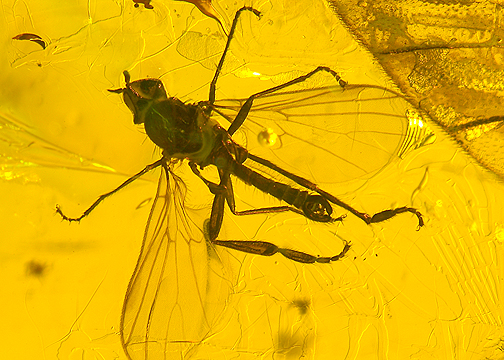Abstract
The Atelestidae are a small family of empidoid flies (Diptera: Empidoidea), including 15 recent species in five genera (Sinclair & Grimaldi, 2020). In contrast, they have a rather high fossil diversity (Table 1), with 28 species in nine genera. These fossil taxa are almost entirely from Cretaceous ambers (Canadian, Lebanese, Myanmar, New Jersey, Spanish), and prior to this study only a single described species from Baltic amber (Nemedina eocenica Sinclair & Arnaud, 2001) was known. The extant species are widespread, with two Afrotropical, three Neotropical, two Nearctic and eight Palaearctic species. This family is recognized within the Empidoidea on the basis of their well-developed anal lobe of the wing, distinct alula, R4+5 unforked, M1+2 usually unforked or forked beyond cell dm, cell cua long, at least as long as cell bm, female tergite 10 absent, male terminalia symmetrical and unrotated, with elongate gonocoxal apodemes and shortened hypandrium (Chvála, 1983; Grimaldi & Cumming, 1999; Sinclair & Cumming, 2006).
References
- Chvála, M. (1983) The Empidoidea (Diptera) of Fennoscandia and Denmark. II. General Part. The families Hybotidae, Atelestidae and Microphoridae. Fauna Entomologica Scandinavica, 12, 1–279. https://doi.org/10.1163/9789004273375_004
- Cumming, J.M. & Wood, D.M. (2017) [Chapter] 3. Adult morphology and terminology. In: Kirk-Spriggs, A.H. & Sinclair, B.J. (Eds), Manual of Afrotropical Diptera. Volume 1. Introductory chapters and keys to Diptera families. Suricata 4, South African National Biodiversity Institute, Pretoria, pp. 89–133.
- Grimaldi, D.A. & Cumming, J.M. (1999) Brachyceran Diptera in Cretaceous ambers and Mesozoic diversification of the Eremoneura. Bulletin of the American Museum of Natural History, 239, 1–124.
- Kasiński, J.R., Kramarska, R., Słodkowska, B., Sivkov, V. & Piwocki, M. (2020) Paleocene and Eocene deposits on the eastern margin of the Gulf of Gdańsk (Yantarny P-1 bore hole, Kaliningrad region, Russia). Geological Quarterly, 64, 29–53. https://doi.org/10.7306/gq.1513
- MacLachlan, R. (1875) A sketch of our present knowledge of the neuropterous fauna of Japan. Transactions of the Entomological Society of London, 23, 167–190. https://doi.org/10.1111/j.1365-2311.1875.tb01906.x
- Meunier, F. (1908) Monographie des Empidae de l’ambre de la Baltique et catalogue bibliographique complet sur les diptères fossils de cette résine. Annales des Sciences Naturelles, Zoologie, (9) 7, 81–135, pls III–XII.
- Shamshev, I.V. & Perkovsky, E.E. (2022) A review of fossil taxa of Microphorinae (Diptera, Dolichopodidae sensu lato), with redescription of the Eocene genus Meghyperiella Meunier. Zootaxa, 5150 (3), 411–427. https://doi.org/10.11646/zootaxa.5150.3.6
- Sinclair, B.J. & Arnaud, P.H. Jr. (2001) Nemedina eocenica new species (Diptera: Empidoidea) from Baltic amber. Myia, 6, 1–8.
- Sinclair, B.J. & Cumming, J.M. (2006) The morphology, higher-level phylogeny and classification of the Empidoidea (Diptera). Zootaxa, 1180 (1), 1–172. https://doi.org/10.11646/zootaxa.1180.1.1
- Sinclair, B.J. & Grimaldi, D.A. (2020) Cretaceous diversity of the relict genus Alavesia Waters and Arillo (Diptera: Empidoidea: Atelestidae). American Museum Novitates, 3961, 1–40. https://doi.org/10.1206/3961.1
- Soszyńska-Maj, A. & Krzemiński, W. (2013) Family Panorpodidae (Insecta, Mecoptera) from Baltic amber (upper Eocene): new species, redescription and palaeogeographic remarks of relict scorpionflies. Zootaxa, 3636 (3), 489–499. https://doi.org/10.11646/zootaxa.3636.3.7
- Ulrich, H. (2004) Phylogenetic considerations about an early colonization of the sea coasts by Dolichopodidae (Diptera). Studia Dipterologica, 11 (1), 233–243.


